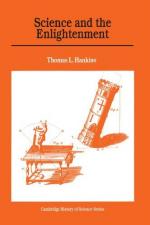|
This section contains 528 words (approx. 2 pages at 400 words per page) |

|
Science and the Enlightenment Summary & Study Guide Description
Science and the Enlightenment Summary & Study Guide includes comprehensive information and analysis to help you understand the book. This study guide contains the following sections:
This detailed literature summary also contains Topics for Discussion and a Free Quiz on Science and the Enlightenment by Thomas L. Hankins.
Science and the Enlightenment is an intellectual and scientific history of the great flowering of scientific and philosophic thought during the 18th century in Europe, the period known as the Enlightenment. The Enlightenment was both an important and radical break with tradition and the foundation of modern science and thought. This book documents that development.
At the outset of the Enlightenment, thinkers were beginning to rebel and move beyond the stifling dogma of Aristotelian thought that had been enforced by the Catholic church since the 11th century. It is no surprise that Enlightenment thought grew out of the work of two Englishmen, who lived in a land that had divorced itself from the Catholic Church. It was Newton and Bacon who developed many of the ideas that led to the Enlightenment both advocating the adoption of the inductive method of observation and theorizing and making a radical break from any reliance on religious revelation or on Catholic philosophy. These initial developments in England led to ripples on the continent of Europe, especially in France and Germany.
It wasn't long after Newton's discoveries that other mathematicians in Europe attempted to continue and expand Newton's discoveries. Descartes developed analytic geometry and Leibniz developed new methods for understanding calculus. These and other developments in mathematics led to further developments in Astronomy and, ultimately, in mechanics.
Until the development of more sophisticated mathematical tools, pure math would have to wait until the 19th century for more advancement. The Enlightenment did see a development in experimental physics, however. Newton contributed to this field greatly as did other scientists. Although many of their theories were ultimately incorrect, the work in this field did lead to many practical developments in the field of electricity and heat research.
It was chemistry, however, that was affected the most by new developments during the Enlightenment. Previously chemistry was the province of Alchemists and doctors, but the Enlightenment saw the development of chemistry as an independent and important field of science. Geniuses like Boyle and Lavoisier developed theories that helped to demolish the old Aristotelian theory of elements and to establish the molecular theory of gases and liquids.
Natural history, or what we might call Biology, and physiology were also created as independent field in this era. While mechanists and vitalists battled it out in the theoretical realm, scientists such as Linnaeus quietly put together the foundations of modern biology and physiology.
Great as these developments were, it was the development in the moral or what we might call the social sciences which were the most influential. Philosophers like David Hume, Rousseau, and Montesquieu developed theories of human nature and law that are still with us today. The Physiocrat in France developed a natural theory of economics that Adam Smith used as the basis of his own theory of economics. Men like Condorcet used the new mathematical techniques to found a quantitative social science and ethical theorists attempted to discover the natural root of our ethical theories and sentiments. In all these ways, this book shows the development of these fields and the birth of modern science out of the ashes of Scholasticism and ignorance.
Read more from the Study Guide
|
This section contains 528 words (approx. 2 pages at 400 words per page) |

|



